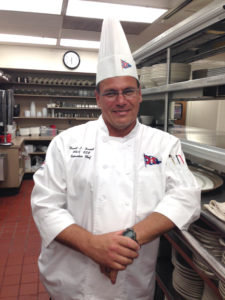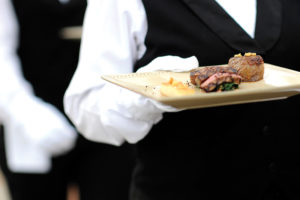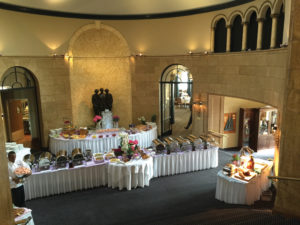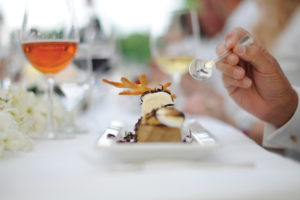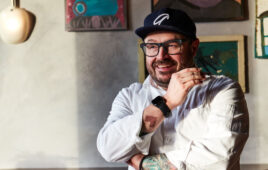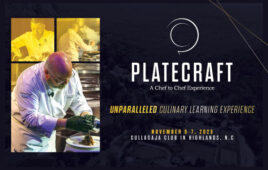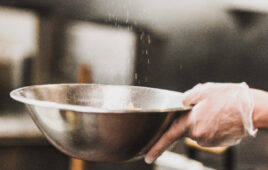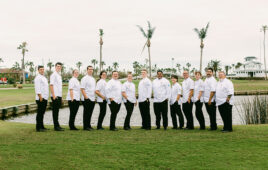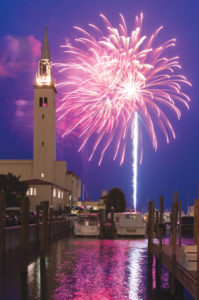
Grosse Pointe Yacht Club’s 187-ft.-high steeple not only brings distinction to its clubhouse, it also serves as a navigational aid for boaters on Lake St. Clair.
Executive Chef David Daniot, CEC, has come home to help steer Grosse Pointe Yacht Club into exciting new culinary channels.
Grosse Pointe Yacht Club (GPYC), in Grosse Pointe Shores, Mich., celebrated its 100th anniversary last year. The club sits on the shores of Lake St. Clair just north of Detroit, with facilities that are listed on the National Register of Historic Places. The spectacular clubhouse and its 187-ft.-high steeple serve as a navigational aid to boaters on the lake. In 1997, GPYC received the prestigious honor of being named the “#1 Yacht Club in America.”
|
CHEF PROFILE Education: Certifications: |
At the helm in the GPYC kitchen is Executive Chef David Daniot, CEC, a native of the Grosse Pointe area. Chef Daniot is a Certified Master Chef candidate and has been putting his contemporary spins on long-time club favorites since his arrival in 2013. The culinary program is a key component in maintaining GPYC’s exemplary reputation, and as he was getting ready for another busy season, Chef Daniot took the time to share some insights on how he and his staff help to continue to bring distinction to all that the club provides for its membership.
C&RB: Chef, you now have your dream job, having been born and raised in the Grosse Pointe area. During the interview process, you had an interesting challenge. Can you tell us about what it involved, and if you would recommend the same process for other clubs?
Daniot: Growing up in the area and knowing the standards of excellence that Grosse Pointe Yacht Club has always represented, it has been a career-long dream of mine to work here, and I am honored to be where I am today.
While I have had difficult challenges during other interview processes in the past, GPYC presented one that was especially unique. After a national search and lengthy interview process, the final candidates were asked to prepare a fairly diverse menu of appetizers, entrees, and desserts that would be served to between 40 and 50 of the club’s most active members in a typical a la carte setting. Each candidate had four hours to prepare the meal, and some of the club’s key culinary team members were made available to assist, as well as evaluate, during preparation and service.
I approached this as if it was a competition or practice run for the Certified Master Chef designation, which I am in the process of pursuing. I crafted a menu that best represented my culinary philosophy and allowed me to cook in the style that I believe in. From specialty ingredients and custom spice blends to the large trunks of equipment used for competitions, I brought everything I needed with me, leaving nothing to chance.
Would I recommend this process for other clubs that are looking for chefs? I can say that the challenge of executing such a menu under those conditions certainly demonstrates a candidate’s ability to perform under fire in an unfamiliar environment—which, if successful, demonstrates desirable traits for a new chef.
C&RB: Can you tell us about the “pop up” dinners that have become a very successful program at GPYC?
Daniot: Borrowing from the current dining trend of “pop up” dinners, GPYC has hosted similar events at the club. Capped at 24 guests, an e-mail is sent to the membership, and reservations are taken on a first-come, first-served basis. No menu or venue details are given until the time of the event.
These events typically sell out immediately, and they also afford me extraordinary creativity in menu development. For example, a winter theme dinner consisted of Nordic-inspired cuisine, while a summer dinner had high-end renditions of summer classics.
C&RB: Chef, it seems like everyone I speak with this year has a successful pizza program. Can you tell us about yours and what it involves in terms of product and staffing needs, venue, oven, etc.?
Daniot: Our pizza oven is located on a poolside terrace, and has proven to be a very successful part of GPYC’s in-season culinary operations. By applying the same cooking philosophy of simplicity, quality, and freshness that we adhere to in our main kitchens, we are able to produce a far superior end-product in our pizza operation than what is available elsewhere.
Our dough begins with Tipo 00 Caputo flour, and that standard of quality is carried out throughout the pizza-making process. These pizzas are fully baked in 90 seconds in an imported Italian dome oven. Utilizing a staff of two supported by my Executive Sous Chef, sales have consistently exceeded $50,000 in the three-month summer season, making it a profitable operation as well.
C&RB: I see that you have some icons on your menu recognizing “Gluten Free” and “Vegetarian” dishes. Where do you think we are headed, as far as private clubs are concerned, with dietary needs and allergies needing to be in print?
Daniot Whether by choice or necessity, members are searching out more and more gluten-free, vegetarian, and vegan dining options. With diners becoming more food-savvy, producing a steamed vegetable plate just doesn’t cut it anymore.
As chefs, we need to put the same efforts into cooking elegant dishes made from grains, legumes, and fresh seasonal vegetables as we put into our finest cuts of meat and fish. Learning how to cook and bake with alternate flours, fats, and leavening agents can add a hand-crafted dimension to our allergen-friendly menus as well.
C&RB: David, you are one of the few chefs that I know with an MBA. How has that business education helped you as a chef?
Daniot: Having a solid business education allows me to more effectively navigate the business side of the club industry. Whether it’s by being able to better interpret the financial documents that we encounter each day as chefs, or by developing budgets, charting dining trends, and utilizing the full technological resources that we have available today, increasingly the value of that type of education is beyond measure.
C&RB: You’re an approved Certified Master Chef candidate—what does that mean, and am I right that you’ve been invited back to attempt the test again in 2016?

GPYC celebrated its 100th
anniversary in 2014 and is listed on the National Register of Historic Places.
Daniot: It is not an “invite” per se. A chef has to accumulate the necessary educational and experience requirements, along with securing the rather sizable financial investment that the exam will require. Employers need to support the candidate as well, understanding that there will be time spent away for practice sessions, in addition to the time required for the exam.
Once that is accomplished, potential candidates have the challenge of securing two letters of recommendation from current CMCs who can vouch for the candidate’s preparedness for the exam.
C&RB: What did you learn from the first test, and what will you be working on before you retake it?
Daniot: Without question, my candidacy for the CMC designation has had the most impact on my abilities as a cook. The years spent in preparation for the exam have made me more humble and a far better cook, through constant refinement and improvement. You are constantly being critiqued by your mentors and encouraged to push yourself to new limits.
Hanging in my kitchen is a quote from one of my mentors that reads: “Are you a better cook than you were yesterday? Will you be a better cook tomorrow than you are today?” I make it a point to learn one new technique, term, concept or food item each day.
For the next exam, I simply need to cook from the heart and cook food that I believe in, focusing on perfect execution of fundamentals. I also need to relax and only worry about things that I can control. As I was reminded during the last exam, it is a test of one’s mastery of cooking, and a successful candidate should be able to pass with nothing more than a knife roll under his or her arm.

